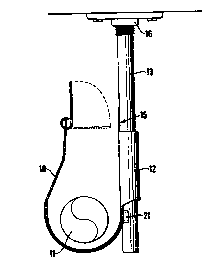Some of the information on this Web page has been provided by external sources. The Government of Canada is not responsible for the accuracy, reliability or currency of the information supplied by external sources. Users wishing to rely upon this information should consult directly with the source of the information. Content provided by external sources is not subject to official languages, privacy and accessibility requirements.
Any discrepancies in the text and image of the Claims and Abstract are due to differing posting times. Text of the Claims and Abstract are posted:
| (12) Patent Application: | (11) CA 2331830 |
|---|---|
| (54) English Title: | IMPROVEMENTS IN OR RELATING TO THE SUPPORT OF PIPES AND OTHER ELEMENTS FROM WALLS AND CEILINGS |
| (54) French Title: | PERFECTIONNEMENTS RELATIFS A LA FIXATION DE TUYAUX ET AUTRES ELEMENTS SUR DES PAROIS ET PLAFONDS |
| Status: | Deemed Abandoned and Beyond the Period of Reinstatement - Pending Response to Notice of Disregarded Communication |
| (51) International Patent Classification (IPC): |
|
|---|---|
| (72) Inventors : |
|
| (73) Owners : |
|
| (71) Applicants : |
|
| (74) Agent: | MOFFAT & CO. |
| (74) Associate agent: | |
| (45) Issued: | |
| (86) PCT Filing Date: | 1999-05-07 |
| (87) Open to Public Inspection: | 1999-11-11 |
| Availability of licence: | N/A |
| Dedicated to the Public: | N/A |
| (25) Language of filing: | English |
| Patent Cooperation Treaty (PCT): | Yes |
|---|---|
| (86) PCT Filing Number: | PCT/GB1999/001427 |
| (87) International Publication Number: | WO 1999057472 |
| (85) National Entry: | 2000-11-07 |
| (30) Application Priority Data: | ||||||
|---|---|---|---|---|---|---|
|
The present invention relates to improvements in or relating to the support of
pipes (11) and other elongate elements from walls and ceilings. In particular
it relates to a hanger of particular use in suspending pipes (11) and/or
cables, especially in heating and air-conditioning installations and plumbing
generally. There is described a support device comprising means to receive and
retain, in use, an object and including adjustable engagement means to receive
and retain a threaded rod (13). The engagement means comprises at least one
channel provided in a face of the support device, the channel being of similar
cross-sectional dimensions to the threaded rod and including a lateral toothed
ridge (25), the teeth of which, in use, engage the thread of the rod (13) to
retain the rod (13) in position within the channel.
La présente invention se rapporte à des perfectionnements relatifs à la fixation de tuyaux (11) et autres éléments oblongs sur des parois et plafonds. Elle se rapporte notamment à un élément de support conçu particulièrement pour fixer des tuyaux (11) et/ou des câbles, notamment dans des installations de chauffage ou de climatisation et de manière générale en plomberie. L'invention se rapporte à un dispositif de support comportant un organe conçu pour recevoir et retenir, en cours d'utilisation, un objet et comprenant un organe d'accouplement réglable conçu pour recevoir et retenir une tige filetée (13). L'organe d'accouplement comporte au moins une gorge ménagée sur une face du dispositif de support, ladite gorge ayant des dimensions de section transversale identique à celle de la tige filetée et comportant une arête (25) munie de dents qui, en cours d'utilisation, entre en contact avec le filetage de la tige (13) de manière à maintenir celle dernière dans sa position à l'intérieur de la gorge.
Note: Claims are shown in the official language in which they were submitted.
Note: Descriptions are shown in the official language in which they were submitted.

2024-08-01:As part of the Next Generation Patents (NGP) transition, the Canadian Patents Database (CPD) now contains a more detailed Event History, which replicates the Event Log of our new back-office solution.
Please note that "Inactive:" events refers to events no longer in use in our new back-office solution.
For a clearer understanding of the status of the application/patent presented on this page, the site Disclaimer , as well as the definitions for Patent , Event History , Maintenance Fee and Payment History should be consulted.
| Description | Date |
|---|---|
| Application Not Reinstated by Deadline | 2003-05-07 |
| Time Limit for Reversal Expired | 2003-05-07 |
| Deemed Abandoned - Failure to Respond to Maintenance Fee Notice | 2002-05-07 |
| Inactive: Cover page published | 2001-03-09 |
| Inactive: First IPC assigned | 2001-03-07 |
| Inactive: Notice - National entry - No RFE | 2001-02-27 |
| Inactive: Inventor deleted | 2001-02-26 |
| Application Received - PCT | 2001-02-19 |
| Application Published (Open to Public Inspection) | 1999-11-11 |
| Abandonment Date | Reason | Reinstatement Date |
|---|---|---|
| 2002-05-07 |
The last payment was received on 2001-04-09
Note : If the full payment has not been received on or before the date indicated, a further fee may be required which may be one of the following
Please refer to the CIPO Patent Fees web page to see all current fee amounts.
| Fee Type | Anniversary Year | Due Date | Paid Date |
|---|---|---|---|
| Basic national fee - small | 2000-11-07 | ||
| MF (application, 2nd anniv.) - small | 02 | 2001-05-07 | 2001-04-09 |
Note: Records showing the ownership history in alphabetical order.
| Current Owners on Record |
|---|
| BERNARD LEACH |
| Past Owners on Record |
|---|
| None |